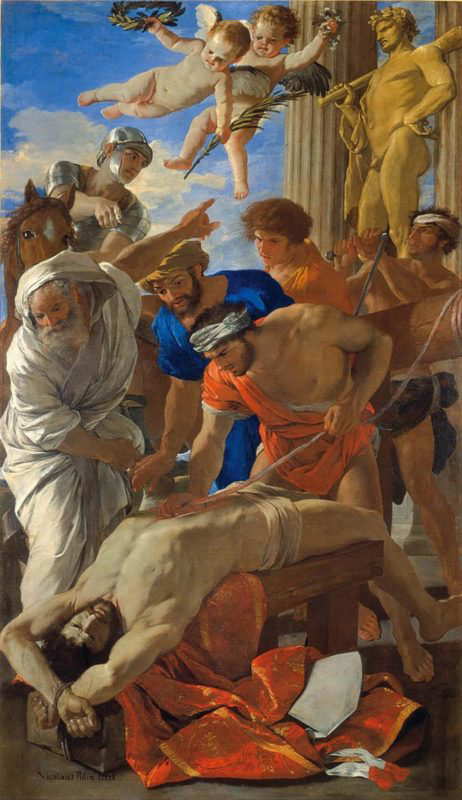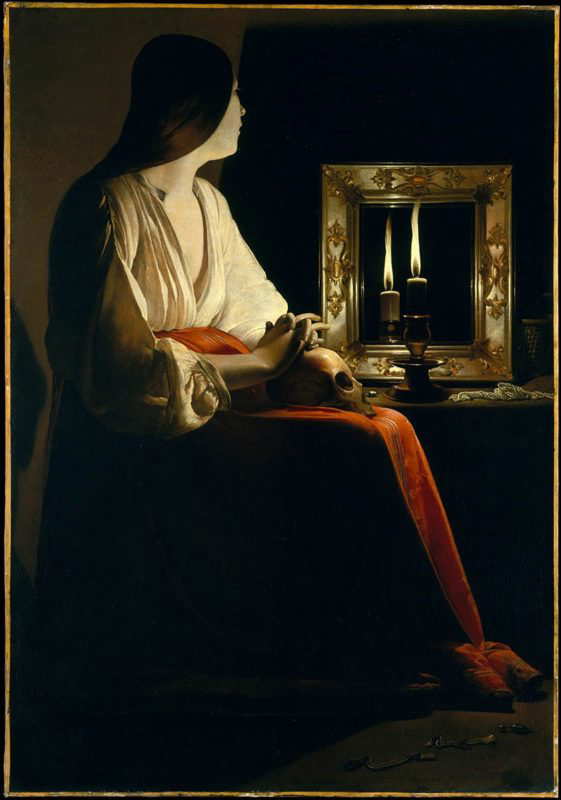
The seventeenth century, categorized as the Baroque, was a period of vast societal, religious, and artistic changes across Europe. Baroque art’s characteristics include the use of tenebrism, dynamic compositions, heightened color, and drama. During this time, artists continually challenged and broke the artistic rules established in the Renaissance. Baroque art aimed to stir emotions and incorporate theatricality into visual media. Despite the experimentation within art and challenging artistic norms, the Catholic church continued to use artwork as propaganda. This article aims to analyze and discuss the Catholic church’s propaganda of enforcing gender roles and behavior within Baroque art.
Reformation And Counter-Reformations Influences On Religious Baroque Art

Martyrdom has been a popular subject in Baroque art, often used to inspire prayer, piety, and encourage virtuous behavior. Before the Protestant Reformation of the sixteenth century, artists took creative liberties in depicting biblical and religious events. The Counter-Reformation established the Council of Trent to address the various criticisms against the Catholic Church. One complaint included the use of religious imagery and icons in Baroque art under the accusation of idolatry. This permitted the continuation of producing religious images and icons while serving a higher purpose as counter-reformative indoctrination. The depiction of saints serves as religious propaganda, evoking piety, and strengthening the influence of the church in everyday life. Using these images was one way the Catholic church continued to assert papal authority.
Why Depict Martyrdom At All?

Depicting martyrdom seems counterproductive to the church’s assertion of authority, as it creates admiration and inspiration for civil disobedience. Paganism was the majority religion in ancient Rome; Christianity was illegal until 313 AD. The persecution of Christians in Rome justified civil disobedience and insubordination in Rome. The introduction of Christianity in ancient Rome threatened the daily practices of everyday life. Daily routines, including civic duties, had incorporations of religious practices. In terms of religious ideology, faith and devotion transcend the “norms” within the society one is present in. Christianity was effectively a counterculture within Rome, whose practices challenged the status quo. While post-modern society could view applauding martyrdom as praising criminal acts, consider the severity of religious persecution throughout history. Persecution and intolerance came from the fear of replacement of the current governmental and societal systems. Simply put, this posed the greatest threat to those in power in ancient Rome.

Depictions of martyred male and female saints tend to greatly differ. Males were more depicted overall. The moments within the saints’ martyrdom greatly contrast between male and female subjects. Males are usually depicted during the specific time of their martyrdom. Alternatively, females often are shown before their martyrdom, or afterward, yet appear physically unaffected. One argument is that this was to dismiss their sacrifice due to their gender. A woman willing to sacrifice herself for her beliefs similar to a man elevates her to his level. In pre-Modern society, this threatens the men who rule. One archaic belief stated that for a woman to become a martyr, “she must shed her femininity and cowardice [to be] masculine”, and therefore courageous. Thus, the concept of depicting women during their martyrdom is too violent, and more particularly, too masculine. This would directly challenge the church’s (and Baroque society’s) patriarchal rule.
Get the latest articles delivered to your inbox
Sign up to our Free Weekly Newsletter
Depictions Of Female Martyrdom: Spot The Symbols

Commonly, depictions of female martyrs include holding a palm frond and a symbol of her martyrdom in her hands. For example, in Francisco de Zubarán’s Saint Apollonia, she holds one of her teeth, implying the martyrdom has already occurred. However, there is no indication of torture, teeth removal, or death anywhere on her body. Without the items she holds and her halo, the average seventeenth-century person would not be able to identify her. Religious iconography plays a crucial role in telling the stories of female saints. This was because the ability to read was reserved for the upper class, the educated, and the clergy. Although literacy continued to rise in Europe, it was still generally reserved for the elite, and more specifically, the men. Because of this, the general public relied on symbols from Biblical stories to interpret who figures in an image were.

Another example of representations of martyrdom through symbolism is Artemisia Gentileschi’s Self-Portrait as Saint Catherine of Alexandria. Without her palm frond and wheel, she is only identified as the artist, in the form of a self-portrait. If these specific symbols and details were not present, these images would be nothing more than paintings of women. Depictions of these saints reflect expectations of them in Baroque society: calmness, quietness, and demureness. There is little indication of violence or questioning the status-quo, which conflicts with the concept of martyrdom almost entirely. This propagandist tactic serves as a device to visually equate and influence women of the Baroque era. By isolating these saints from an environment, the artists are willfully removing the intense drama present during martyrdom.
Not-So-Graphic-Violence

Female saints are depicted within Baroque art, albeit less frequently than male saints. However, the depictions are less graphic and violent than those of their male counterparts. Some examples can be seen in the following images: Caravaggio’s The Martyrdom of Saint Ursula, Francesco Furini’s St. Christina of Bolsena. Both Saint Ursula and Saint Christina of Bolsena were shot with arrows. Both images lack the intensity or response expected when someone is dying. Both saints remain calm and composed despite their impending deaths and ongoing torture. Had it not been for the arrow piercing her, Saint Ursula’s expression would not indicate pain whatsoever. The only additional context is provided by those around her, who have more animated reactions than her. Saint Christina’s exposed breast and saddened expression provide a bit more context, although what is occurring is unclear. The expectation is that all potential intensity is psychological and inward, rather than physical and outward.

Alternatively, Saint Cecilia is depicted at the moment of her death. However, her face is turned away from the viewer, emphasizing her attempted beheading, exposing a small wound across her neck. This small wound serves as a symbol of her martyrdom. In addition to her martyrdom, the neck wound symbolizes how her body was believed to have been found: incorruptible. By observing and demonstrating her incorruptibility, the concept of her (or any female saint’s purity) is reinforced. Even in death, she is still beautiful and wholly pure. Maderno’s positioning of the body contributes to the overall message communicated in most representations of female saints. The decision to have her face turned away further reinforces the societal expectations placed on women. Her actual mouth, which is not visible, is silenced. The wound on her neck serves as a secondary mouth and visual cue about the consequences of defying authority.
A History Of Silencing Women

Unsurprisingly, the suppression of women’s voices is not uncommon within Catholicism. One of the greatest examples is the purposeful misidentification of Mary Magdalene as a prostitute. There is no evidence of her being one in either the Golden Legend or the Bible. Her misidentification was a propagandist attempt to invalidate her being one of Jesus Christ’s closest disciples. Rather than acknowledging the significant role she played in Christ’s life, she was almost entirely discredited. The concept of silencing these saints is contradictory to the stories of their martyrdom. Many female martyrs were condemned and killed due to their vows of virginity and devotion to Christianity. Vowing one’s virginity and devotion to religion is something that requires vocalization. By silencing these women within art, during the times they would be most vocal, is counterproductive to inspiring devotion. The message is inconsistent- be devout but do not be vocal about said devotion.
What About Male Martyrs?

In stark contrast, male martyrs’ experiences of violent and visceral martyrdom are graphically depicted. In Caravaggio’s The Crucifixion of Saint Peter, the viewer sees Peter being tied and raised on an inverted cross. The image evokes feelings of empathy and awe, seeing a fully imagined scene of Peter’s final moments. This scene provides all of the information to show what is occurring. The audience has a full view of the nails in Peter’s hands and feet and the fear in his eyes. No detail was spared, going so far as to include the exertion of Peter’s executioners. Unlike the female saints, Peter’s emotions are easily read: he is fearful, angry, and defiant. With this image, we see a man fighting until his last breath for what he believes in. An entirely different message is conveyed to male viewers: be loud, proud, and have your voice heard at any cost.

In Francisco de Zubarán’s Martyrdom of Saint Serapion, it is unclear at what point during his martyrdom Zubarán depicted. There are various accounts of Serapion’s death. The most widely accepted belief is that he was bound to poles, beaten, dismembered, and disemboweled. In this case, Zubarán’s choice to depict Serapion before the dismemberment and disemboweling is unusual. Even though this occurs before his (final) final moments, it distinctly bears a different message than similar images of female saints. The beaten body of Serapion confronts the audience. In contrast to his female counterparts, what occurs is painfully clear. This is a holy man being tortured to death- as evident by his clothing and his pose. There is no uncertainty as to what will happen: he will die if he is not already dead. Rather than implying the pain he endured, as subtly done with the female martyrs, viewers directly witness it.
Final Thoughts On Martyrdom In Baroque Art

While martyrdom is a popular motif in Baroque art, the handling of male and female saints was significantly different. The ultimate goal of the church was to reinforce gender-specific expectations of appropriate behavior and exert papal authority. Depicting male martyrs required martyrdom to be equated to masculine: confrontational, visceral, and unavoidable. The visual handling of female martyrs subjected to the same fate was vastly different. To do so would equate men to women, an idea that seventeenth-century Catholicism did not want to encourage. Baroque art became an important part of the propaganda machine maintaining the continuous tight grip on power that the church had. Indicating societal expectations placed on both sexes of the seventeenth century in Baroque art was effectively subtle. The actions and beliefs of these saints were examples in which the public should follow.








